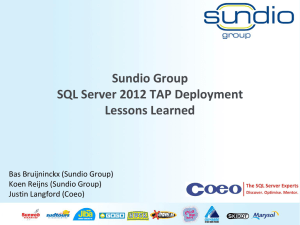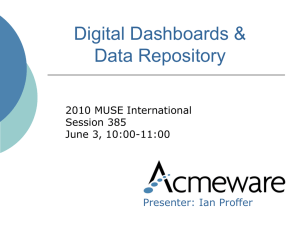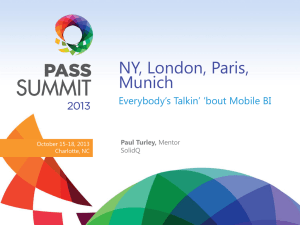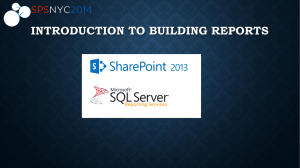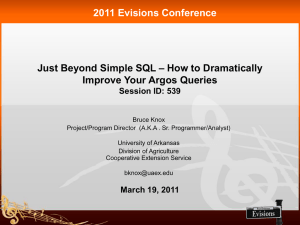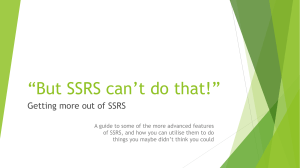Introducing the - Chicago SQL BI User Group > Home
advertisement
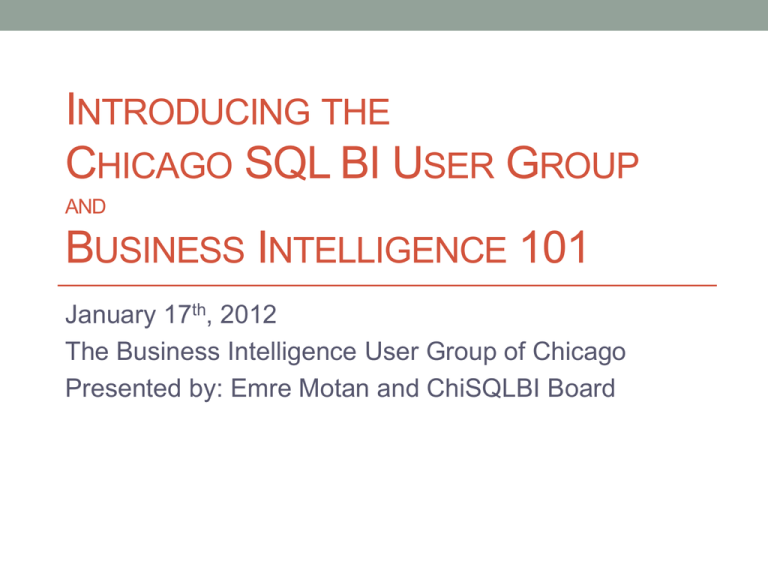
INTRODUCING THE CHICAGO SQL BI USER GROUP AND BUSINESS INTELLIGENCE 101 January 17th, 2012 The Business Intelligence User Group of Chicago Presented by: Emre Motan and ChiSQLBI Board Agenda Introducing the Chicago SQL BI User Group • Introduction to PASS • BI Professionals and Chicago • Introducing the Chicago SQL BI User Group • Topics of Interest for Members, Speakers, and Sponsors Business Intelligence 101 • What is Business Intelligence? • Microsoft BI vs. The Competition • Components in Microsoft’s BI Stack • Demo of SQL 2012’s PowerView application Introduction to PASS • The Professional Association for SQL Server (PASS) sponsors chapters around the world. • Chicago’s local groups include one downtown and one in the western suburbs. BI Professionals and Chicago • SQL Server BI used by many companies • SQL Server BI professionals in high demand by recruiters • Existing PASS SSUGs in Chicago focus on DBA topics • Existing BI groups in Chicago are multi-faceted • Business Intelligence User Group of Chicago (Meetup.com) • The Chicago Business Intelligence Group (Meetup.com) • Business Intelligence Roundtable (ITA) • Need for SQL Server BI-focused group The Chicago SQL BI User Group • Opportunity for members to meet, learn, and network • Speakers, both experienced and novice, offered chance to present knowledge and build speaking portfolio • Sponsors sought to provide food, prizes, and swag in exchange for recognition • SQL Server User Groups collaborate for events such as SQL Saturday and the PASS Summit Board of Directors • Marcello Benati • Director of BI, Rightpoint Consulting • Jung Choi • Data Architect, Sg2 • Tom Huguelet • BI Architect, contextQ, BlueGranite, SolidQ • Tom Jaskula • Senior BI Consultant, MPS Partners • Jake Kremer • Solutions Architect, Project Leadership Associates • Emre Motan • Data Architect, Northwestern University Medical EDW Topics of Interest (examples) • Data Warehousing using SQL Server • Data modeling, dimensional analysis • Technical challenges and approaches • SSIS • Best practices, novel applications, data warehouse implementation • SSRS • Portal management, SharePoint integration, novel designs • SSAS • Cube development, optimization, management • Data mining principles and applications • SQL BI Enterprise Architecture What is Business Intelligence? • Philosophically, it is the process of transforming data into information that enables valuable, actionable decisions • The business purpose of BI is to derive value from decisions enabled by analysis on business data typically from operational systems • In practice, BI refers to the management, transformation, storage, analysis, and presentation of information How does BI work? SSIS & SQL Server SSAS SSRS SSRS Portal SharePoint Excel with PowerPivot PowerView How Microsoft Meets BI Needs • Microsoft offers SQL Server and its Business Intelligence stack • SQL Server holds data and provides T-SQL query engine • SSIS (Integration Services) provides tools to extract, transform, and load data (ETL) • SSAS (Analysis Services) provides tools to build multidimensional databases, develop data mining models, and query engine from cubes • SSRS (Reporting Services) provides tool to build reports and a portal to deploy reports so end users can run reports • Business Intelligence Development Studio (BIDS) is Visual Studio development environment for SQL BI Major Players in BI Market • In 2010, Gartner put Microsoft in the “leaders” quadrant with 8.7% market share along with Oracle, Microstrategy, IBM, and others. 2010 2010 Market 2009 2009 Market 2009-2010 Revenue Share (%) Revenue Share (%) Growth SAP 2,413.10 22.9 2,066.20 22.3 16.8 Oracle 1,645.80 15.6 1,350.50 14.6 21.9 SAS Institute 1,386.50 13.2 1,324.60 14..3 4.7 IBM 1,222.00 11.6 1,135.60 12.2 7.6 Microsoft 913.7 8.7 739.5 8 23.6 Other Vendors 2,940.60 27.9 2,661.50 28.7 10.5 Total 10,521.80 100 9,277.90 100 13.4 Company Traditional BI vs. Self-Service BI • Microsoft intends to cater to both traditional and self- service BI customers with its varied offerings Traditional BI Information is delivered by: - Reports via subscription - Reports in SSRS portal - Reports in SharePoint - Static Dashboards Competitors: Oracle, IBM, SAP Self-Service BI Users develop information by: - Querying against cubes and data warehouse using Excel with PowerPivot - Browsing and drilling down interactive dashboards using PowerView Competitors: Qlikview, Tableau How do you purchase SQL Server? • Single Users • Demo licenses, SQL Server Express, and Developer edition are available for a nominal price ($50) • Boxed Software • Companies can purchase software and install on their own servers • BI Appliances • Custom-built hardware with software and customizations included can be bought from vendors such HP and their Business Decision Appliance • Cloud • Microsoft offers SQL Azure (SQL Server) and Reporting Services over their cloud network SSIS – Integration Services • Tools to extract, transform, and load (ETL) data • Extract data from source databases or flat files • Transform data using SSIS components • Load data into destination tables or flat files • Can be used for a multitude of tasks, not just populating a database • File copying, moving, automation, etc. • Querying analytical applications • Parsing files such as XML and outputting contents • For BI, typically used to populate ODS and data marts • Can be used to merge data and populate master reference data based on inputs SSAS – Analysis Services • Provides analytical capabilities on top of SQL Server • Allows creation of “cubes” which are multidimensional databases • Cubes can be considered as highly optimized pivot tables • Numerical data is held in “fact” table (e.g. inventory count, dollars) • Attributes are held in “dimension” tables (e.g. products, countries) • End users can query cubes using Excel or data can be fed to others applications like SSRS reports and data mining models • MDX language is used to query SSAS cubes; DMX language used to query Data Mining models built on SSAS cubes SSRS – Reporting Services • Report building and presentation application • Users build reports in BIDS and deploy to SSRS portal • Portal manages security by role • Subscriptions can be programmed to deliver reports • Dashboards are a popular use of SSRS • Empowers management to get high level view of metrics and then dig deeper into specific areas via drill-down reports • Example: Northwestern uses custom built .NET portal on top of SSRS to management authorization in a securityheavy organization • E.G. Users can browse reports but have to request access to view contents Solutions for MS BI Shortcomings • Metadata Management • Northwestern created a Metadata Browser that scrapes metadata from SQL system tables. • Packages that populate data warehouse tables (both ODS and DM) modify metadata repository with data such as last populated date • SSIS Package Management and Auditing • Version control is possible (packages are XML files) but cumbersome • Northwestern uses custom auditing solution for packages (ETL Execution Logs, metadata columns to each destination like execution GUID and datetime) • SSIS frameworks exist, such as in book SSIS 2008 Problem, Design, and Solution • Managing jobs and schedules • SQL Server Agent should be used to schedule jobs and track history • Third-Party products such as SQL Sentry are useful for auditing and management Demo – PowerView



